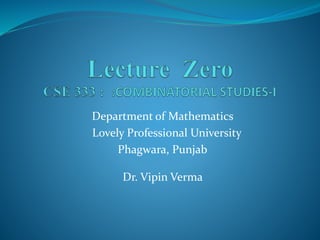
Lecture Zero CSE 333 11 KE117.pptx
- 1. Department of Mathematics Lovely Professional University Phagwara, Punjab Dr. Vipin Verma
- 2. Contents Course Details Course Objectives Text / Reference Books Course Assessment Model Course Contents Learning Outcomes
- 3. Course Details Course Credits L-T-P : 3-0-0
- 4. Course Objectives Practice all the mathematical theories and concepts important for a computer science engineer. Identify the utility of mathematics in higher studies. Score good marks in higher studies related competitive exam like GATE.. Evaluate different mathematical theories related to Discrete Mathematics, Linear Algebra, Calculus, and Probability.
- 5. Books Text Book DISCRETE MATHEMATICS AND ITS APPLICATIONS WITH COMBINATORICS AND GRAPH THEORY by KENNETH H. ROSEN, Mc Graw Hill Education ADVANCED ENGINEERING MATHEMATICS by R K JAIN, NAROSA PUBLISHING HOUSE Reference Books ENGINEERING MATHEMATICS II by T VEERARAJAN, Mc Graw Hill Education FUNDAMENTALS OF MATHEMATICAL STATISTICS by GUPTA S.C. , KAPOOR V.K., SULTAN CHAND & SONS (P) LTD.
- 6. Course Assessment Model Attendance CA (Best two out of three tests) : MCQ MTE : MCQ ETE : MCQ
- 7. Course Contents Discrete Mathematics : propositional logic, first order logic, sets, relations, functions, partial orders, lattices, groups Graphs : connectivity, matching, coloring Combinatorics : counting, recurrence relations, generating functions Linear Algebra : matrices, determinants, system of linear equations, eigenvalues, eigenvectors, LU decomposition Calculus : limits, continuity, differentiability, maxima and minima, mean value theorem, integration Probability : random variables, uniform, normal, exponential, Poisson and binomial distributions, mean, median, mode, standard deviation, conditional probability, Bayes theorem Numerical Ability : numerical computation, numerical estimation, numerical reasoning, data interpretation
- 8. Learning Outcomes On successful completion of the course, the students should be able to: Understand the Relations and their properties, Equivalence relations, Partial ordering relations, Lattice, Sub lattice Understand and able to apply the concepts of Graph theory in real life application Understand and able to apply the concepts of Matrices Understand and able to apply the concepts of probability distribution.
- 9. A set is an unordered collection of objects, called elements or members of the set. A set is said to contain its elements. We write a ∈ A to denote that a is an element of the set A. The notation a ∈ A denotes that a is not an element of the set A.
- 20. Q 1 If A and B are sets and A∪ B= A ∩ B, then A. A = Φ B. B = Φ C. A = B D. none of these
- 22. Q2. If X and Y are two sets, then the compliment of X ∩ (Y ∪ X) equals A. X B. Y C. Ø D. None of these
- 23. Thank You